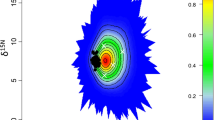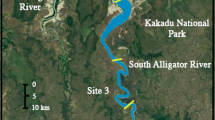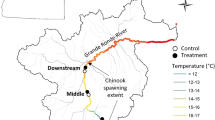Abstract
A tier III, essential fish habitat analysis was used to evaluate the biochemical condition of common mummichog Fundulus heteroclitus residing in two isolated tidal salt marshes, one a relatively undisturbed polyhaline site dominated by Spartina alterniflora and the other a meso-oligohaline site dominated by an invasive variety of Phragmites australis. Stable isotopes signatures of C, N, and S in whole tissue samples of F. heteroclitus were used to compare the trophic spectrum for this species in each marsh as a function of the dominant macrophytes present with additional contributions from phytoplankton and benthic microalgae. Allometry of wet mass and its components, water mass, lean protein mass and lipid mass in individual fish exhibited hyperallometric patterns; and average lipid mass fell within the range reported for most fundulids, including F. heteroclitus. Significant differences were also detected in the allocation of lipid classes to energy reserves in the form of triacylglycerols (TAG) and free fatty acids. These reserves, especially TAG, are critical for reproduction, migration, and overwintering survival in many taxa and were significantly lower in fish collected in the P. australis-dominated marsh. Relative to the relatively undisturbed Spartina-dominated site, we tentatively conclude that the P. australis-invaded marsh was an inferior habitat for F. heteroclitus.






Similar content being viewed by others
References
Able, K.W. 1999. Measures of juvenile fish habitat quality: examples from a national estuarine research reserve. American Fisheries Society Symposium 22: 134–147.
Able, K.W., S.M. Hagan, and S.A. Brown. 2003. Mechanisms of marsh habitat alteration due to Phragmites response of young-of-year mummichog (Fundulus heteroclitus) to treatment for Phragmites removal. Estuaries 26(2B): 484–494.
Ackman, R.G. 1980. Fish lipids, Part I. In Advances in fish science and technology, ed. J.J. Connell, 86–103. Oxford: Fishing New Books.
Ackman, R.G. and C.A. Eaton. 1976. Variations in fillet lipid content and some lipid-iodine value relationships for large winter Atlantic herring from southeastern Newfoundland. Journal of the Fisheries Research Board of Canada 33: 1634–1638.
Angradi, T.R., S.M. Hagan, and K.W. Able. 2001. Vegetation type and the intertidal macroinvertebrate fauna of a brackish marsh: Phragmites vs. Spartina. Wetlands 21: 75–92.
Beck, M.W., K.L. Heck Jr., K.W. Able, D.L. Childers, D.B. Eggleston, B.M. Gillanders, B. Halpern, C.G. Hays, L. Hoshino, T.J. Minello, R.J. Orth, P.F. Sheridan, and M.P. Weinstein. 2001. The identification, conservation, and management of estuarine and marine nurseries for fish and invertebrates. Bioscience 51: 633–641.
Burnett, K.G., L.J. Bain, W.S. Baldwin, G.V. Callard, S. Cohen, R.T. Di Giulio, D.H. Evans, M. Gomez-Chiarra, M.E. Hahn, E.C. Hoover, S.I. Karchner, F. Katoh, D.L. MacLatchy, W.S. Marshall, J.N. Meyer, D.E. Nacci, M.F. Oleksiak, B.B. Rees, T.D. Singer, J.J. Stegman, D.W. Towle, P.A. Van Veld, W.K. Volgebein, A. Whitehead, R.N. Winn, and D.L. Crawford. 2007. Fundulus as the premier teleost model in environmental biology: opportunities for new insights using genomics. Comparative Biochemistry and Physiology (D) 2: 257–286.
Childers, D.L., J.W. Day Jr., and H.N. McKellar Jr. 2000. Twenty more years of marsh and estuarine flux studies: revisiting Nixon. In Concepts and controversies in tidal marsh ecology, ed. M.P. Weinstein and D.A. Kreeger, 391–424. Dordrecht: Kluwer Academic.
Currin, C.A., S.C. Wainright, K.W. Able, M.P. Weinstein, and C.M. Fuller. 2003. Determination of food web support and trophic position of the mummichog, Fundulus heteroclitus, in New Jersey smooth cordgrass (Spartina alterniflora), common reed (Phragmites australis), and restored salt marshes. Estuaries 26(2B): 495–510.
De Vlaming, V.L., A. Kuris, and F.R. Parker Jr. 1978. Seasonal variation of reproduction and lipid reserves in some subtropical cyprinodontids. Transactions of the American Fisheries Society 10: 464–472.
Deegan, L.A. and R.H. Garritt. 1997. Evidence for spatial variability in estuarine food webs. Marine Ecology Progress Series 147: 31–47.
Deegan, L.A., J.E. Hughes, and R.A. Rountree. 2000. Salt marsh ecosystem support of marine transient species. In Concepts and controversies in tidal marsh ecology, ed. M.P. Weinstein and D.A. Kreeger, 333–368. Dordrecht: Kluwer Academic.
Fangue, N.A., M. Mandic, J.G. Richards, and P.M. Schulte. 2008. Swimming performance and energetic as a function of temperature in killifish Fundulus heteroclitus. Physiological and Biochemical Ecology 81: 389–401.
Folch, J., M. Lees, and G.H. Sloan-Stanley. 1957. A simple method for the isolation and purification of lipids from animal tissues. Journal of Biological Chemistry 226: 497–509.
Fullerton, A.H., J.E. Garvey, R.A. Wright, and R.A. Stein. 2000. Overwinter growth and survival of largemouth bass: interactions among size, food, origin, and winter severity. Transactions of the American Fisheries Society 129: 1–12.
Griffith, R.W. 1974. Environment and salinity tolerance in the genus Fundulus. Copeia 2: 319–331.
Hagan, S.M., S.A. Brown, and K.W. Able. 2007. Production of mummichog (Fundulus heteroclitus): response in marshes treated for common reed (Phragmites australis) removal. Wetlands 27: 54–67.
Hanson, S.R., D.T. Osgood, and D.J. Yozzo. 2002. Nekton use of a Phragmites australis marsh on the Hudson River, New York, USA. Wetlands 22: 326–337.
Hardy JD Jr. Development of fishes of the mid-Atlantic Bight: an atlas of egg, larval and juvenile states. Vol. 2: Anguillidae through Syngnathidae. U.S. Fish and Wildlife Service, Biological Services Program, FWS/OBS-78/12; 1978.
Heintz, R.A., D.N. Bonita, J.H. Hudson, M. Larsen, and L. Holland. 2004. Marine subsidies in freshwater: Effects of salmon carcasses on lipid class and fatty acid composition of juvenile coho salmon. Transactions of the American Fisheries Society 133: 559–567.
Henderson, R.J. and D.R. Tocher. 1987. The lipid composition and biochemistry of freshwater fish. Progress in Lipid Research 26: 281–347.
Hunter, K.L., D.A. Fox, L.M. Brown, and K.W. Able. 2006. Responses of resident marsh fishes to stages of Phragmites australis invasion in three mid-Atlantic estuaries. Estuaries and Coasts 29: 487–498.
Hurst, T.P. 2007. Causes and consequences of winter mortality in fishes. Journal of Fish Biology 71: 315–345.
Hurst, T.P., E.T. Schultz, and D.O. Conover. 2000. Seasonal energy dynamics of young of the year Hudson River striped bass. Transactions of the American Fisheries Society 129: 145–157.
Levins, R. 1968. Evolution in changing environments. New Jersey: Princeton University Press.
Litvin, S.Y. and M.P. Weinstein. 2003. Life history strategies of estuarine nekton: the role of marsh macrophytes, microphytobenthos and phytoplankton in the trophic spectrum. Estuaries 26(B): 553-653.
Litvin, S.Y. and M.P. Weinstein. 2004. Multivariate analysis of stable isotope ratios to infer movements and utilization of estuarine organic matter by juvenile weakfish (Cynoscion regalis). Canadian Journal of Fisheries and Aquatic Sciences 61: 1851–1861.
Lochmann, S.E. and G.M. Ludwig. 2003. Relative triacylglycerol and morphometric measures of condition in sunshine bass fry. North American Journal of Aquaculture 65: 191–2003.
Lochmann, S.E., G.L. Maillet, K.T. Frank, and C.T. Taggart. 1995. Lipid class composition as a measure of nutritional condition in individual larval Atlantic cod (Gadus morhua). Canadian Journal of Fisheries and Aquatic Science 52: 1294–1306.
Lochmann, S.E., G.L. Maillet, C.T. Taggart, and K.T. Frank. 1996. Effects of gut contents and lipid degradation on condition measures in larval fish. Marine Ecology Progress Series 134: 27–35.
Long, E.R., D.D. Macdonald, S.L. Smith, and F.D. Calder. 1995. Incidence of adverse biological effects within ranges of chemical concentrations in marine and estuarine sediments. Environmental Management 19: 81–97.
Meredith, W.H. and V.A. Lotrich. 1979. Production dynamics of a tidal creek population of Fundulus heteroclitus (Linnaeuas). Estuarine and Coastal Marine Science 8: 99–118.
Mommsen, T.P. 1998. Growth and metabolism. In The physiology of fishes, 2nd ed, ed. D.H. Evans, 127–173. New York: Academic.
Montalto, F.A., T.S. Steenhuis, and J.Y. Parlange. 2005. The hydrology of Piermont Marsh, a reference for tidal marsh restoration in the Hudson River estuary, New York. Journal of Hydrology 316: 108–128.
Montevecchi, W.A. and J. Piatt. 1984. Composition and energy contents of mature inshore spawning capelin (Mallotus villosus): implications for seabird predators. Comparative Biochemistry and Physiology 78A: 15–20.
Osgood, D.T., D.J. Yozzo, R.M. Chambers, S. Pianka, J. Lewis, and C. LePage. 2006. Patterns of habitat utilization by resident nekton in Phragmites and Typha marshes on the Hudson River Estuary, New York. American Fisheries Society Symposium 51: 151–173.
Parrish, C.C. 1987. Separation of aquatic lipid classes by chromarod thin-layer chromatography with measurement by Iatroscan flame ionization detection. Canadian Journal of Fisheries and Aquatic Science 44: 722–731.
Polis, G.A. and D.R. Strong. 1996. Food web complexity and community dynamics. American Naturalist 147: 813–846.
Polis, G.A., R.D. Holt, R.A. Menge, and K. Winemiller. 1995. Time, space, and life history: influences on food webs. In Food webs: integration of patterns and dynamics, ed. G.A. Polis and K. Winemiller, 435–460. New York: Chapman & Hall.
Posey, M.H., T.D. Alphin, D.L. Meyer, and J.M. Johnson. 2003. Benthic communities of common reed Phragmites australis and marsh cordgrass Spartina alterniflora marshes in Chesapeake Bay. Marine Ecology Progress Series 261: 51-61.
Post, J.R. and E.A. Parkinson. 2001. Energy allocation strategy in young fish: allometry and survival. Ecology 82: 1040–1051.
Raichel, D.L., K.W. Able, and J.M. Hartman. 2003. The influence of Phragmites (common reed) on the distribution, abundance, and potential prey of a resident marsh fish in the Hackensack Meadowlands, New Jersey. Estuaries 26(2B): 511–521.
Ross, D.A. and R.M. Love. 1979. Decrease in the cold-store flavor developed by frozen fillets of starved cod (Gadus morhua L.). Journal of Food Technology 14: 115–122.
Saltonstall, K. 2002. Cryptic invasion by a non-native genotype of the common reed, Phragmites australis, into North America. Proceedings of the National Academy of Sciences 99: 2445–2449.
Schultz, E.T. and D.O. Conover. 1999. The allometry of energy reserve depletion: test of a mechanism for size dependent winter mortality. Oecologia 119: 474–483.
Scott, G.R., D.W. Baker, P.M. Schulte, and C.M. Wood. 2008. Physiological and molecular mechanisms of osmoregulatory plasticity in killifish after seawater transfer. Journal of Experimental Biology 211: 2450-2459.
Seber, G.A.F. 1973. The estimation of animal abundance. London: Griffen.
Shulman, G.E. and R.M. Love. 1999. The biochemical ecology of marine fishes. In 1–347 Advances in marine biology, vol 36, ed. A.J. Southward, P.A. Tyler, and C.M. Young, 1–347. London: Academic.
Slotte, A. 1999. Differential utilization of energy during wintering and spring-spawning migration in Norwegian spring spawned herring. Journal of Fish Biology 54: 338–355.
Smith, K.J. and K.W. Able. 1994. Salt-marsh tide pools as winter refuges for the mummichog, Fundulus heteroclitus, in New Jersey. Estuaries 17: 226–234.
Smith, K.J. and K.W. Able. 2003. Dissolved oxygen dynamics in salt marsh pools and its potential impacts on fish assemblages. Marine Ecology Progress Series 258: 223–232.
Snyder, E.D. 1983. Chapter 9. Fish eggs and larvae. In Fisheries techniques, ed. L.A. Nielsen and D.L. Johnson, 165–197. Bethesda: American Fisheries Society.
SPSS. SPSS®. Version 12.0 for Windows® (SYSTAT) [computer program]. Chicago: SPSS; 2007.
Sutton, S.G., T.P. Bult, and R.L. Haedrich. 2000. Relationships among fat weight, body weight, water weight, and condition factors in wild Atlantic salmon parr. Transactions of the American Fisheries Society 129: 527–538.
Teo, S.L.H. and K.W. Able. 2003. Habitat use and movement of the mummichog (Fundulus heteroclitus) in a restored salt marsh. Estuaries 26: 720–730.
USEPA. 1994. Notice of sediment quality criteria. Federal Register 59: 2652–2656.
USEPA. National coastal condition report. Washington: Office of Research and Development, Office of Water; 2001. EPA-620R-01/005.
Valiela, I., J.E. Wright, J.M. Teal, and S.B. Volkman. 1977. Growth, production and energy transformations in the salt marsh killifish, Fundulus heteroclitus. Marine Biology 40: 135–144.
Wainright, S.A., M.P. Weinstein, K.W. Able, and C.A. Currin. 2000. Relative importance of benthic microalgae, phytoplankton and detritus of smooth cordgrass (Spartina) and the common reed (Phragmites) to brackish marsh food webs. Marine Ecology Progress Series 200: 77–91.
Walters, C.J. and F. Juanes. 1993. Recruitment limitation as a consequence of natural selection for use of restricted feeding habitats and predation risk taking by juvenile fishes. Canadian Journal of Fisheries and Aquatic Science 50: 2058–2070.
Wannamaker, C.M. and J.A. Rice. 2000. Effects of hypoxia on movements and behavior of selected estuarine organisms from the southeastern United States. Journal of Experimental Biology and Ecology 249: 145–163.
Weinstein, M.P. and J.H. Balletto. 1999. Does the common reed, Phragmites australis reduce essential habitat for fishes? Estuaries 22(3B): 793–802.
Weinstein, M.P., J.H. Balletto, J.M. Teal, and D.F. Ludwig. 1997. Success criteria and adaptive management for a large-scale wetland restoration project. Wetlands Ecology and Management 4: 111–127.
Weinstein, M.P., S.Y. Litvin, K.I. Bosley, C.M. Fuller, and S.C. Wainright. 2000. The role of tidal salt marsh as an energy source for juvenile marine transient finfishes: a stable isotope approach. Transactions of the American Fisheries Society 129: 797–810.
Weinstein MP, Keough JR, Gutenspergen GR (editors). Phragmites australis: a sheep in wolf’s clothing? Estuaries. 2003;26(2B):397–629.
Weinstein, M.P., S.Y. Litvin, and V.G. Guida. 2005. Consideration of habitat linkages, estuarine landscapes and the trophic spectrum in wetland restoration design. Journal of Coastal Research, Special Issue 40: 51–63.
Weisburg, S.B., R.P. Morin, E.A. Ross, and M.F. Hirshfield. 1986. Eustrongylides (Nematoda) infection in mummichogs and other fishes of the Chesapeake Bay region. Transactions of the American Fisheries Society 115: 776–783.
Weisburg, S.B., J.A. Ranasinghe, D.D. Dauer, L.C. Schaffner, R.J. Diaz, and J. Frithsen. 1997. An estuarine benthic index of biotic integrity (B-IBI) for Chesapeake Bay. Estuaries 20: 149–158.
Weld, M.M. and A.H. Meier. 1984. Circadian responses of gonads and fat stores to handling of Gulf killifish. Transactions of the American Fisheries Society 113: 521–527.
Windham, L. and R.G. Lathrop Jr. 1999. Effects of Phragmites australis (common reed) invasion on aboveground biomass and soil properties in brackish tidal marsh of the Mullica River, New Jersey. Estuaries 22: 927–935.
Winogrand, H.G. and E. Kiviat. 1997. Invasion of Phragmites australis in the tidal marshes of the Hudson River. Section VI. In Final report of the Tibor T. Polgar Fellowship Program, 1996, ed. W.C. Neider and J.R. Waldman, 29. New York: Hudson River Foundation.
Wolfe, D.A., E.R. Long, and G.B. Thursby. 1996. Sediment toxicity in the Hudson-Raritan Estuary: distribution and correlations with chemical contamination. Estuaries 19: 901–912.
Yuneva, T.V., G.E. Shulman, and A.M. Shcepkina. 1991. The dynamics of lipid characteristics in horse-mackerel during swimming. Zhurnal Evolutsionnoy Biochimmi i Physiologii 27: 730–735.
Acknowledgments
We thank G. Sobotka for assistance in the laboratory, and P. Rowe, A. Avizius, and S. Strauss for their help in the field. S. Vincent kindly donated specimens of F. heteroclitus captured in Piermont Marsh tide pools. This study was supported by United States Environmental Protection Agency, grant no. X7-97280601, and posted as contribution # ISS 2009-0001, Institute of Sustainability Studies, Montclair State University.
Author information
Authors and Affiliations
Corresponding author
Rights and permissions
About this article
Cite this article
Weinstein, M.P., Litvin, S.Y. & Guida, V.G. Essential Fish Habitat and Wetland Restoration Success: A Tier III Approach to the Biochemical Condition of Common Mummichog Fundulus heteroclitus in Common Reed Phragmites australis- and Smooth Cordgrass Spartina alterniflora-Dominated Salt Marshes. Estuaries and Coasts 32, 1011–1022 (2009). https://doi.org/10.1007/s12237-009-9185-5
Received:
Accepted:
Published:
Issue Date:
DOI: https://doi.org/10.1007/s12237-009-9185-5




